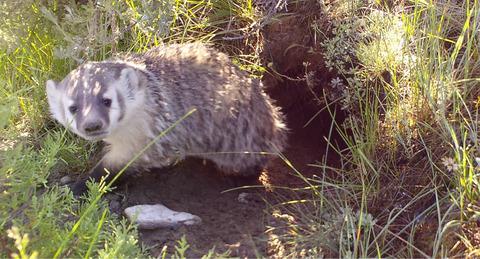当前位置:
X-MOL 学术
›
Ecol. Evol.
›
论文详情
Our official English website, www.x-mol.net, welcomes your
feedback! (Note: you will need to create a separate account there.)
Burrow webs: Clawing the surface of interactions with burrows excavated by American badgers
Ecology and Evolution ( IF 2.3 ) Pub Date : 2021-07-30 , DOI: 10.1002/ece3.7962 Megan L Andersen 1 , Drew E Bennett 1 , Joseph D Holbrook 1, 2
Ecology and Evolution ( IF 2.3 ) Pub Date : 2021-07-30 , DOI: 10.1002/ece3.7962 Megan L Andersen 1 , Drew E Bennett 1 , Joseph D Holbrook 1, 2
Affiliation

|
Ecosystem engineers are organisms that influence their environment, which includes alterations leading to habitat provisioning for other species. Perhaps the most well-examined guild of species provisioning habitat for other species is tree cavity excavators or woodpeckers (Picidae). Many studies have examined the suite of secondary cavity users that rely on woodpeckers, and how the ecological network of secondary users, collectively referred to as the nest web, changes across communities. Despite similar habitat provisioning processes, fewer studies have assessed the suite of species associated with burrowers providing access to subterranean habitat. Here, we begin to characterize the burrow web provisioned by American badgers (Taxidea taxus) and evaluate the diversity and frequency of species interactions we detected at abandoned badger burrows in Wyoming, USA. We deployed camera traps at 23 badger burrows and identified interactions with the burrow by birds, mammals, and reptiles. Overall, we discovered 31 other species utilizing badger burrows, consisting of 12 mammals, 18 birds, and 1 reptile. Mammals, other than American badgers themselves and other fossorial species such as ground squirrels (Urocitellus sp.), frequently using burrows included mice (Peromyscus sp.), long-tailed weasel (Mustela frenata), pygmy rabbit (Brachylagus idahoensis), and desert cottontail (Sylvilagus audubonii). Of the 18 bird species detected, most accounted for <5% of overall detections, besides chipping sparrows (Spizella passerina) at 7.2%–11.5% of detections. The most common category of detection by bird species was foraging, contrary to mammals, which used the burrow frequently and were commonly observed entering and exiting the burrow. This work provides additional context on the ecological role of American badgers within their environment. More broadly, this work scratches the surface of many remaining questions to explore with the aim of advancing our understandings about burrow webs across the diversity of burrowing species and the communities in which they occur.
中文翻译:

洞穴网:与美洲獾挖掘的洞穴相互作用的表面
生态系统工程师是影响其环境的有机体,其中包括导致为其他物种提供栖息地的改变。也许为其他物种提供栖息地的最仔细检查的物种行会是树洞挖掘机或啄木鸟(啄木鸟科)。许多研究都研究了依赖啄木鸟的次级腔体用户套件,以及次级用户的生态网络(统称为巢网)如何在社区之间发生变化。尽管栖息地供应过程类似,但评估与提供地下栖息地的穴居动物相关的物种的研究较少。在这里,我们开始描述美洲獾( Taxideataxus )提供的洞穴网的特征,并评估我们在美国怀俄明州废弃的獾洞穴中检测到的物种相互作用的多样性和频率。我们在 23 个獾洞穴中部署了摄像机陷阱,并确定了鸟类、哺乳动物和爬行动物与洞穴的相互作用。总体而言,我们发现了 31 种利用獾洞穴的其他物种,其中包括 12 种哺乳动物、18 种鸟类和 1 种爬行动物。除了美洲獾本身和其他化石物种(如地松鼠 ( Urocitellus sp.))之外,经常使用洞穴的哺乳动物还包括小鼠 ( Peromyscus sp.)、长尾黄鼠狼 ( Mustela frenata )、侏儒兔 ( Brachylagus idahoensis ) 和沙漠棉尾 ( Sylvilagus audubonii )。在检测到的 18 种鸟类中,大多数为 <5 id=93>Spizella passerina ),占检测量的 7.2%–11.5%。 鸟类最常见的检测类别是觅食,这与哺乳动物相反,哺乳动物经常使用洞穴,并且经常观察到进出洞穴。这项工作为美洲獾在其环境中的生态作用提供了更多背景信息。更广泛地说,这项工作触及了许多尚待探索的问题的表面,目的是增进我们对穴居物种及其所在群落多样性的穴居网的理解。
更新日期:2021-09-09
中文翻译:

洞穴网:与美洲獾挖掘的洞穴相互作用的表面
生态系统工程师是影响其环境的有机体,其中包括导致为其他物种提供栖息地的改变。也许为其他物种提供栖息地的最仔细检查的物种行会是树洞挖掘机或啄木鸟(啄木鸟科)。许多研究都研究了依赖啄木鸟的次级腔体用户套件,以及次级用户的生态网络(统称为巢网)如何在社区之间发生变化。尽管栖息地供应过程类似,但评估与提供地下栖息地的穴居动物相关的物种的研究较少。在这里,我们开始描述美洲獾( Taxideataxus )提供的洞穴网的特征,并评估我们在美国怀俄明州废弃的獾洞穴中检测到的物种相互作用的多样性和频率。我们在 23 个獾洞穴中部署了摄像机陷阱,并确定了鸟类、哺乳动物和爬行动物与洞穴的相互作用。总体而言,我们发现了 31 种利用獾洞穴的其他物种,其中包括 12 种哺乳动物、18 种鸟类和 1 种爬行动物。除了美洲獾本身和其他化石物种(如地松鼠 ( Urocitellus sp.))之外,经常使用洞穴的哺乳动物还包括小鼠 ( Peromyscus sp.)、长尾黄鼠狼 ( Mustela frenata )、侏儒兔 ( Brachylagus idahoensis ) 和沙漠棉尾 ( Sylvilagus audubonii )。在检测到的 18 种鸟类中,大多数为 <5 id=93>Spizella passerina ),占检测量的 7.2%–11.5%。 鸟类最常见的检测类别是觅食,这与哺乳动物相反,哺乳动物经常使用洞穴,并且经常观察到进出洞穴。这项工作为美洲獾在其环境中的生态作用提供了更多背景信息。更广泛地说,这项工作触及了许多尚待探索的问题的表面,目的是增进我们对穴居物种及其所在群落多样性的穴居网的理解。











































 京公网安备 11010802027423号
京公网安备 11010802027423号